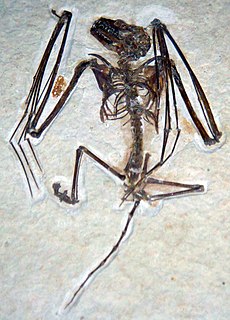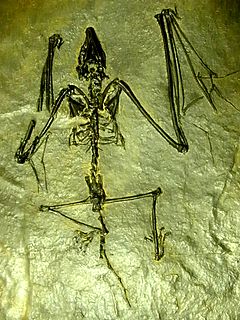
Obdurodon is a genus of extinct monotreme. They appeared much like their modern day relative the platypus, except adults retained their molar teeth. Unlike the platypus which forages on the lakebed, Obdurodon may have foraged in the water column or surface.

Thylacinidae is an extinct family of carnivorous, superficially dog-like marsupials from the order Dasyuromorphia. The only species to survive into modern times was the thylacine, which became extinct in 1936.

Megadermatidae, or false vampire bats, are a family of bats found from central Africa, eastwards through southern Asia, and into Australia. They are relatively large bats, ranging from 6.5 cm to 14 cm in head-body length. They have large eyes, very large ears and a prominent nose-leaf. They have a wide membrane between the hind legs, or uropatagium, but no tail. Many species are a drab brown in color, but some are white, bluish-grey or even olive-green, helping to camouflage them against their preferred roosting environments. They are primarily insectivorous, but will also eat a wide range of small vertebrates.

Icaronycteris is an extinct genus of microchiropteran (echolocating) bat that lived in the early Eocene, approximately 52.2 million years ago, making it the second earliest known definitive bat. Four exceptionally preserved specimens, among the best preserved bat fossils, are known from the Green River Formation of North America. There is only one thoroughly described species of bat in the genus, I. index, although fragmentary material from France has also been tentatively placed within Icaronycteris as the second species I. menui. I. sigei is based on well-preserved fragments of dentaries and lower teeth found in Western India.

Palaeochiropteryx is an extinct genus of bat from the Middle Eocene of Europe. It contains two very similar species – Palaeochiropteryx tupaiodon and Palaeochiropteryx spiegeli, both from the famous Messel Pit of Germany. They are usually found complete and exceptionally preserved, even retaining the outlines of their fur, ears, and wing membranes.

Euryzygoma is an extinct genus of marsupial which inhabited humid eucalyptus forests in Queensland and New South Wales during the Pliocene of Australia. Euryzygoma is believed to have weighed around 500 kg, and differed from other diprotodonts in having unusual, flaring cheekbones that may have been used either for storing food or for sexual display. Euryzygoma is believed to be the ancestral genus from which Diprotodon evolved.

Euowenia is an extinct genus of Diprotodontia which existed from the Pliocene to the upper Pleistocene. Weighing around 500 kg, Euowenia is only known from three locations on mainland Australia, Chinchilla in Queensland, Menindee in New South Wales and the Tirari formation on the Warburton River in the Lake Eyre basin.
Warendja is an extinct genus of marsupial, present from the Late Miocene to the Late Pleistocene, which went extinct in the Quaternary extinction event. Weighing 10 kg, Warendja is the earliest known vombatiforme to exhibit hypsodonty.
Ramsayia was a genus of giant wombat, weighing around 100 kg. Ramsayia went extinct in the Late Pleistocene.

Macroderma is a genus of microbats, present in the fossil record and as one extant species. They have existed in Australia since the early Miocene.
The Murgon fossil site is a paleontological site of early Eocene age in south-eastern Queensland, Australia. It lies near the town of Murgon, some 270 km north-west of Brisbane. The Murgon site is important as the only site on the continent with a diverse range of vertebrate fossils dating from the early Paleogene Period, making it a crucial period in mammal evolution. It is also important in demonstrating Australia's Gondwanan links with South America in the form of similar fossils from the two continents.

Archaeonycteridae is a family of extinct bats. It was originally erected by the Swiss naturalist Pierre Revilliod as Archaeonycterididae to hold the genus Archaeonycteris. It was formerly classified under the superfamily Icaronycteroidea (disused) by Kurten and Anderson in 1980. In 2007, the spelling was corrected to Archaeonycteridae and it was reclassified to the unranked clade Microchiropteramorpha by Smith et al.. The family Palaeochiropterygidae was also merged into Archaeonycteridae by Kurten and Anderson, but modern authorities specializing in bat fossils maintain the distinction between the two.
Ngapakaldia is an extinct genus of diprotodontid marsupials, related to the modern koala and wombat. Around the size of a sheep, it was a ground-dwelling herbivore that lived around the vegetated shores of lakes in Central Australia during the Late Oligocene.
Rhinonicteris tedfordi is an extinct species of microbat, of the order Chiroptera, known from fossil material found in Australia.
Riversleigh fauna is the collective term for any species of animal identified in fossil sites located in the Riversleigh World Heritage Area.
Xenorhinos halli is a species of bat that existed in the early Miocene. It was discovered at a fossil deposit of the Riversleigh World Heritage Area in the north of Australia.
Petramops creaseri is a species of molossid bat discovered in Miocene fossil deposits at the Riversleigh sites.
Riversleigha williamsi is a species of hipposiderid bat discovered in fossil deposits located the Riversleigh World Heritage Area in the north of Australia.
Macroderma godthelpi is a species of bat known from fossil material found in Australia, one of the larger carnivorous megadermatid family of the order Chiroptera. They resembled the modern species Macroderma gigas, known as a false vampire or ghost bat, although significantly smaller than any other species of Macroderma.
Dorcopsoides is a genus of extinct species of kangaroo from the Pliocene of Australia.








